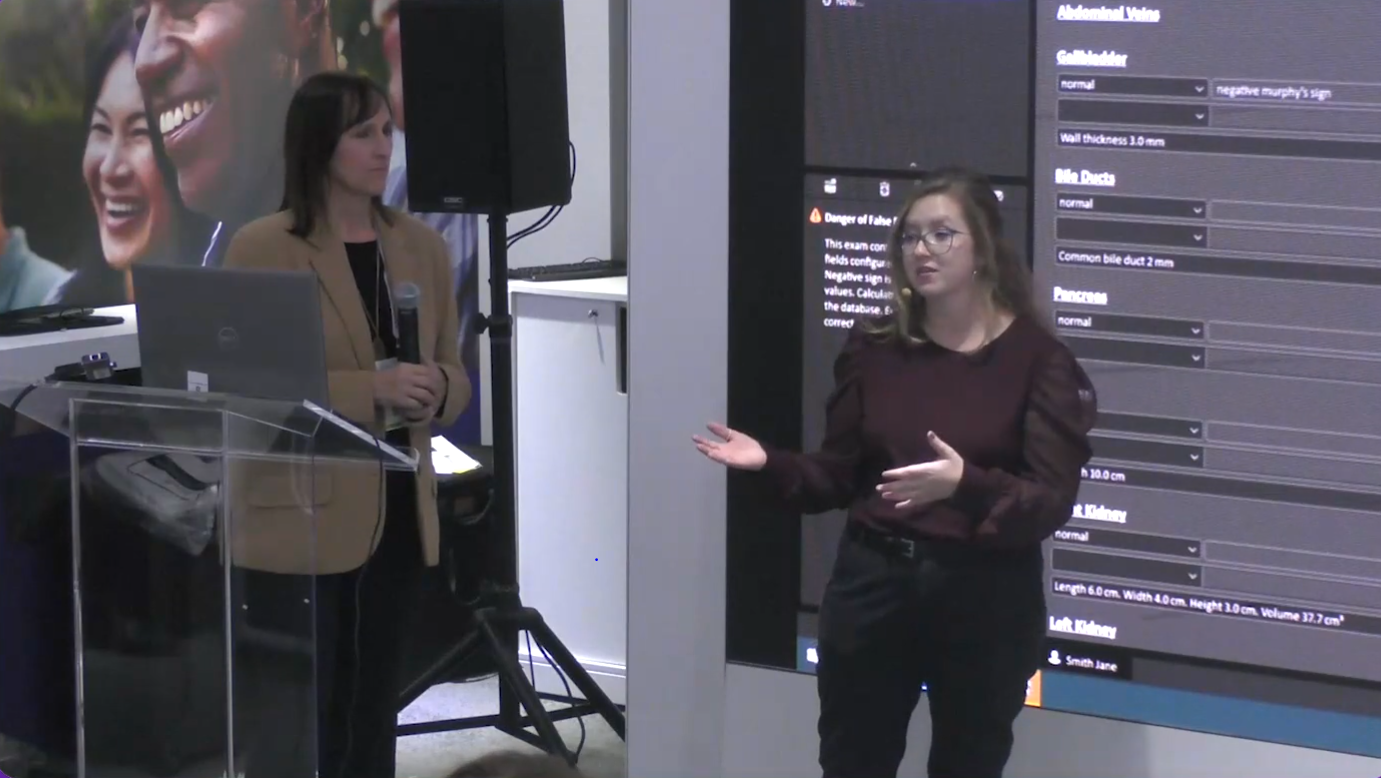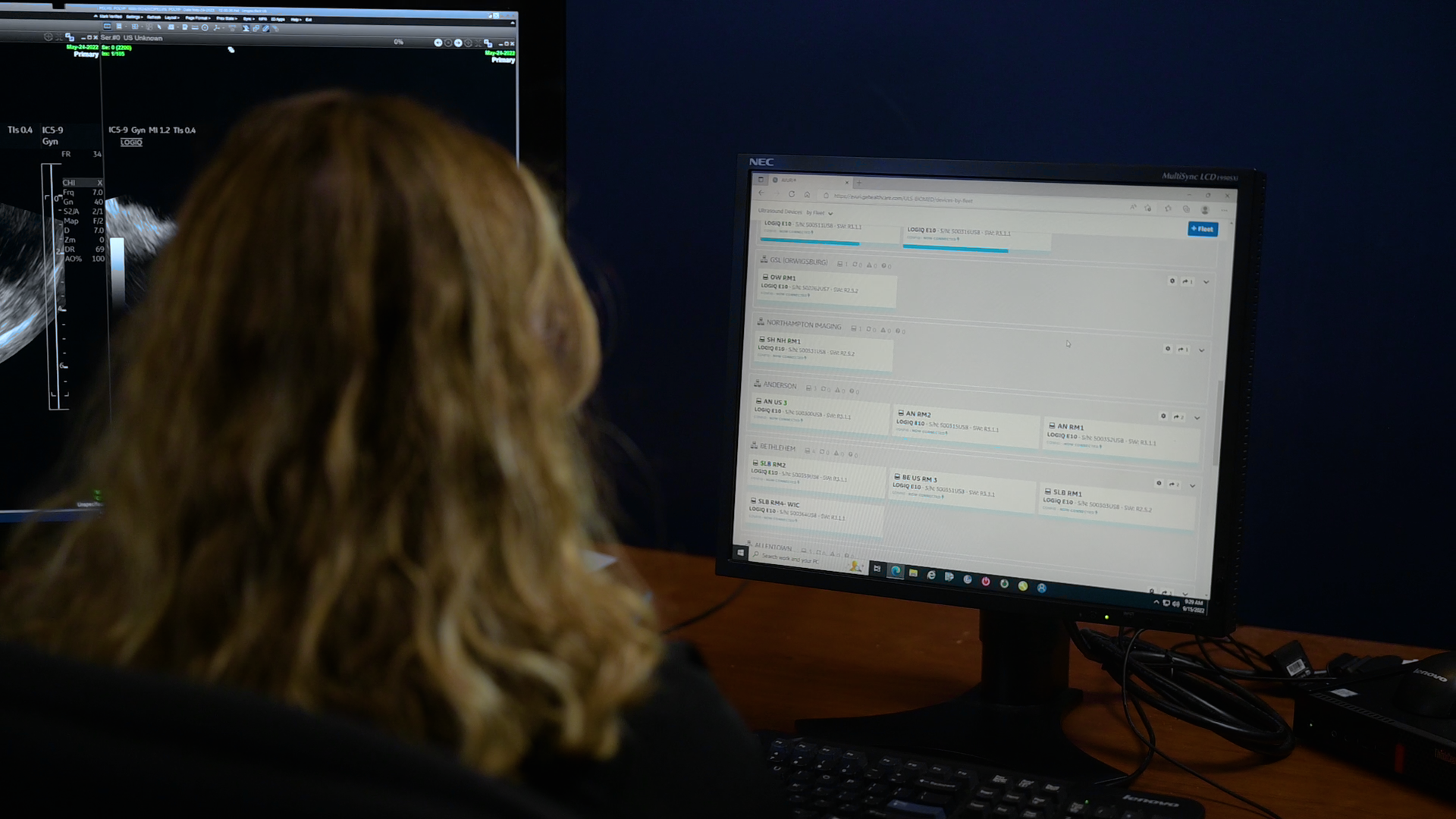“One of the biggest issues in ultrasound is always standardization, which affects our quality,” explained Lauren Fazzolari, Ultrasound Clinical Specialist at St. Luke’s University Health Network (SLUHN), during a presentation at the Radiological Society of North America’s (RSNA) 2024 annual meeting.
“We have 70 ultrasound techs across the network, and it's hard to get them all on the same page,” Dr. Laurie Sebastiano, Section Chief of Ultrasound at SLUHN, added during the event.
Dr. Laurie Sebastiano and Lauren Fazzolari at RSNA 2024
The challenge of standardized ultrasound across multiple sites
Without uniform scanning protocols, SLUHN’s sonographers were capturing images in different sequences. Radiologists had to spend valuable time sorting through unordered images and, at times, crucial measurements were missing. “Sonographers knew which images to capture, but there was no set order. If it was done at one site versus another, there’d be differences,” said Lauren.
SLUHN, a healthcare system operating 14 hospital sites plus numerus outpatient sites across a 50-mile stretch in eastern Pennsylvania, has 49 ultrasound devices in its general imaging fleet. Even minor protocol changes required labor-intensive, on-site updates with USB drives, which made it nearly impossible to keep devices synchronized.
Achieving standardized ultrasound practices with Scan Assistant
To standardize ultrasound imaging while maintaining sonographer autonomy, SLUHN turned to Scan Assistant and VerisoundTM Fleet from GE HealthCare. These technologies work in tandem to enable enterprise-wide scanning protocols.
Scan Assistant simplifies ultrasound exams by automating tasks, guiding sonographers through preset protocols, and even recognizing anatomy for automatic measurements. It reduced abdominal scan times by 22% and OB/GYN scans by 16%1.
The SLUHN team believes Scan Assistant balances standardization with flexibility for sonographers. “We are really proud of our abilities and how we scan—we don’t really like anybody telling us what to do,” shared Lauren, who is also a seasoned sonographer with 13 years of experience. This tool allows sonographers to work in their preferred order, take as many images as they deem necessary, and still ensure exams are organized and sent to PACS according to the institution's established protocols.
"The image presets are the same. The measurements are the same. The comments we use are the same. The order is the same," Lauren said, highlighting the consistency achieved through Scan Assistant. “People can’t go rogue.”
“One of my favorite features of Scan Assistant is we can actually implant anatomy pictures right in the step to show the tech what the expectation is,” said Dr. Sebastiano.
Case Study: Learn more about SLUHN’s struggle with ultrasound standardization, and the results of its Scan Assistant + Verisound Fleet roll-out.
The role of Verisound Fleet in enabling standardization across ultrasound devices
While Scan Assistant addressed the issue of variability in exams, SLUHN still needed a way to deploy these smart protocols to every ultrasound device. “It’s logistically difficult to maintain Scan Assistant without Verisound Fleet,” explained Fazzolari. The cloud-based platform enables remote updates, eliminating travel time and hands-on configurations. “Fleet has totally changed the way we apply updates. Now we can do updates constantly,” she added.
Verisound Fleet enable remote updates, eliminating travel time and hands-on configuration of ultrasound systems.
Standardized ultrasound protocols enhance radiologist workflow and patient care
With Verisound Fleet and Scan Assistant in place, SLUHN saw immediate improvements:
- Standardized imaging became a reality – Now, any sonographer can walk up to any ultrasound machine and perform a scan using the same protocols.
- Radiologists' workflow improved – Studies now “hang” the same way every time, making it easier to compare prior scans and identify changes in a patient’s condition. “It’s nice because it all just lines up when you’re looking from the current to the prior,” said Dr. Sebastiano.
- Compliance became straightforward – SLUHN’s American College of Radiology (ACR) audits improved because all required images and cine loops were consistently captured. If ACR criteria change, SLUHN can easily update its protocols.
- Sonographers gained efficiency – Automated presets eliminated extra keystrokes, reducing strain on sonographers and minimizing errors. “There’s no more typing. They don’t even have to click because the measurement packages are already preset,” Fazzolari noted.
Dr. Sebastiano sees standardization as a win for patients. “If we can be more efficient in what we are doing, if we can provide a confident diagnosis, if we can be more accurate in our comparisons, I think that all trickles down to benefiting the patient,” she said.
Learn more about SLUHN’s struggle with ultrasound standardization, and the results of its Scan Assistant + Verisound Fleet roll-out in this case study.
REFERENCES
1. GE HealthCare Case Study. Scan Assistant: Improving the speed and consistency of ultrasound exams for users of all experience levels at high-volume clinics. Salud Digna clinics in Mexico and Nicaragua, Dec 2020. JB01454XX
Verisound is a trademark of GE HealthCare.
Product and features may not be available in all countries and regions. Full product technical specification is available upon request. Contact a GE HealthCare representative for more information.
©2025 GE HealthCare. GE is a trademark of General Electric Company used under trademark license.



